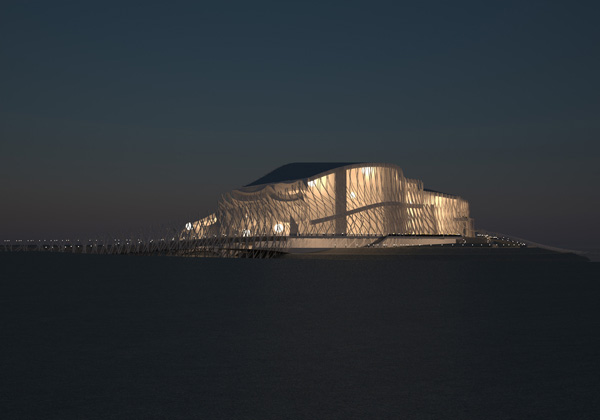 |
| Busan Opera House © Paul Preissner Architects |
Let's start with OODA, a Portugal-based agency composed of Diogo Brito, Rodrigo Vilas-Boas, Francisco Lencastre, Francisco Rugeroni, Ezhil Vigneswaran, Francisca Lopes dos Santos. OODA's proposal explores the relationship of the natural topography and the building.
The building's center area can be rotated around itself to house an Opera with all its requirements, an area for intimate concert, and a centered stage venue. This Opera House contains auxiliary facilities including high level restaurants, café/bars, shopping, convention center, exhibition space, banquet hall, event room, etc.; it also provides natural light, cross ventilation, access and multiple views.
 |
| Busan Opera House proposal © OODA |
The key element to this Busan Opera House is its envelope, a continuous 'coque' (French for shell), to cover these programs. I am curious to know which materials the agency would use for this envelope.
TASK Architects's design proposal is a continuous yet curved surface. It would surprised that the shape of the building explores the relationship of its environment and the nature of the programs. One of the particularities of this proposal is the perforated envelope. The perforation concentrated in some parts on the external skin breaks the unity of the envelope to provide natural light for the internal spaces. Apart from their functions, these 'holes' resonate with the surrounding landscape.
 |
| Busan Opera House proposal © TASK Architects |
Three main exterior spaces are the core elements of this building: the entrance space, the main exterior plaza and the sky terrace. The building is also composed of three halls: a 2000-seat great hall, a multi-purposed hall, a small 200-seat theatre. TASK Architects is composed of Khaled ElAshry, Taymor Senbel, Ahmed Badr ElDin and Aya Ibrahim.
Ayrat Khusnutdinov and Alexey Bychkov of ADM's proposal starts once again with the articulation of its natural environment and the programms: music, dance, etc.
 |
| Busan Opera House proposal © Ayrat Khusnutdinov and Alexey Bychkov/ADM |
This leads to a building conceived as "a musical instrument." The design consists of a cantilevered and fluid building that houses flexible internal spaces: a stage and auditorium, which then intermixed create life, according to the architects. So life, sea, music, dance, are central to this design proposal.
Called Anisotropia, London-based Orproject's Busan Opera House proposal is based on a musical composition for piano, namely Klavierstueck I, composed by Orproject director Christoph Klemmt. This Klavierstueck is a twelve tone row which is repeated and altered by the different voices, as the agency says.
 |
| Busan Opera House © Orproject |
This Klavierstueck defines the facade structure, the shifting and alteration of the patterns, but also the control of light, view and shading properties of the facade.
Orproject is composed of Francesco Brenta, Christoph Klemmt, Laura Micalizzi and Raja Sodhi.
Source: eVolo


No comments:
Post a Comment